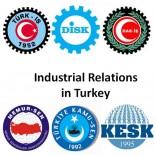Public Sector Unionism in Turkey: Membership, unionization rate and union confederations
Based on the yearly statistics provided by the Turkish ministry of Labour and Social Security (CSGB), the unionization in the public sector in Turkey can be analysed in detail. Further, since the ministry started collecting statistics on Union membership since 2004, some significant time trends are visible.
We here wish to give you an overview of (1) the overall unionization in the Turkish public sector, (2) the relative strength of the three main public sector union confederations, (3) the analysis of the weight of the different sectors in those confederations and (4) the relative strength of the confederations in the public sectors of Turkey.
1. Unionization Rate
According to the official statistics of Turkey, in 2012, more than 1.300.000 civil servants (on a Total of over 2 million civil servants) were members of a union. This gives a unionization rate of about 68%. Ever since 2004, this percentage has been rising steadily. Given the fact that civil servants were only allowed to organize unions since 1992, this high unionization rate is remarkable. We should nevertheless remark that some categories are left out of the statistics as they officially don’t have the right to organize in unions (military personnel, police etc.).
This high unionization rate nevertheless provokes some questions on the validity of the official statistics. Some years ago, official statistics still showed signs of obvious flaws as the resulted in unionization rates of over 100%. The current figures are corrected, yet it is unclear whether they can be fully trusted.
2. Three major confederations: Memur-Sen, Kamu-Sen & KESK
The unions in the Turkish public sector are organized in confederations. Of the eight official confederations, five are relatively small and three are significant in size: Memur-Sen, Kamu-Sen & KESK. In the figure below we show the evolution of membership for the three confederations. Since 2004, the landscape in the Turkish public sector changed dramatically. In 2004, Kamu-Sen and KESK were the largest confederations, followed by the smaller Memur-Sen. Ever since; Memur-Sen grew expansively and became the second largest union in 2007, bypassing KESK in terms of members. Two years later, Memur-Sen even became the largest public sector union and ever since, its growth has not ceased. In 2012, Memur-Sen has about 650.000 members which almost equal the members Kamu-Sen and KESK together.
3. Relative weight of the different sectors of the public service in Turkey
The Turkish public sector is further split up in 11 subsectors in which union branches organize their activities:
- Banking & Insurance
- Education
- Health & Social Services
- Local Authorities
- Communication & Media
- Culture & art
- Infrastructure, architecture
- Transport
- Agriculture
- Energy, mining and industry
- Religious affairs
In each sub sector a branch of the three different confederations is active. Using the membership data of those branches, we can assess the relative weight of the branches in the confederation. As can be seen from the figure below, the educational sector is the largest in all three the union confederations. For Memur-Sen, the education sector union (Egitim Bir Sen) represents about 36% of the members of Memur-Sen. These shares are even higher in Kamu-Sen (Turk Egitim Sen, 49%) and KESK (Egitim Sen, 52%). The second largest sector in all three confederations is the ‘Health and Social services’ sector which represents 27% of the Memur-Sen members, 21% of Kamu-Sen and 17% of KESK.
The third largest sector for Memur-Sen is the sector of ‘religious affairs’. This sector represents about 9% of the members of Memur-Sen in 2012. It is nevertheless remarkable that the relative importance of this branch (Diyanet Sen) shrunk significantly since 2004 when it still represented about 21% of the total members of Memur-Sen.
The third largest sector for Kamu-Sen is the ‘Banking and Insurance’ sector and for KESK it is the ‘Local Authorities’ sector.
4. Relative strength of the confederations in the different sectors
If we approach the statistics from a sector perspective, we can get an idea about the strength of the different confederations (their branches) in each of the 11 sectors of the Turkish civil service. As shown in the figure below, we see that the Memur-Sen branches are the largest union branch in about all civil service sectors in Turkey. Primarily in the sector of religious affairs (74%) and agriculture (69%) sector, the Memur-Sen branches are much stronger than their counterparts of the other two large confederations. In six of the eleven sectors, the Memur-Sen branches represent over half of the total union members.
Kamu-Sen has strong branches in the communication and media sector (42%), the transport sector (39%) and in the banking and Insurance sector (39%), but also in these sectors, the Memur-Sen branches represent a larger share of the unionized workers.
KESK, at last, only has strong branches in the culture and art sector (39%) and in the local authorities sector (31%).
The difference with the situation in 2004 could hardly be larger. In 2004, the KESK branches were the strongest in the local authorities, education and cultural sector. The only sector in which Memur-Sen was the strongest was the religious sector. In all other 7 sectors, the Kamu-Sen branches were the largest.
Publication date: June 19, 2013




